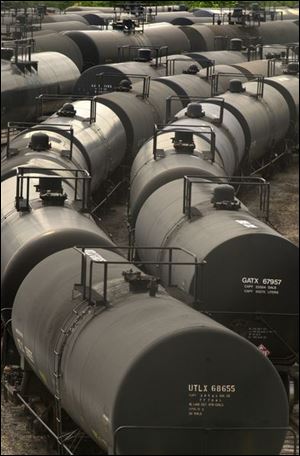
Area rails carry heavy volume of dangerous cargo
7/29/2001
Area fire and safety officials say they are prepared in the event rail cars such as these off of Front Street spill their load in an accident.
When 30 cars of a Conrail freight train derailed in eastern Ottawa County a little more than four years ago, 125 nearby residents had to leave their homes for a day until a car containing chlorine residue was secured.
Derailments in southern Huron County involving hydrochloric acid and propane also required evacuations during the last six years.
Those accidents, and more recently the freight train derailment in a Baltimore tunnel that disrupted the city's downtown for six days, focused national attention on a heavy volume of freight train traffic that usually is unnoticed by the public. Thousands of tons of hazardous materials travel to and through northern Ohio and southern Michigan by rail virtually every day, and a vast majority of shipments are completed without incident.
Neither the Baltimore derailment nor the incidents closer to home caused any serious injuries, however, and area fire and safety officials say they have done as much as they can to prepare for any hazardous-materials problems that may roll down the track.
“We would be up to the task,” said Toledo fire Chief Michael Bell, whose force includes 75 hazmat-trained firefighters and rescue personnel. A hazardous materials incident, he said, “is something you don't rush into - you stabilize your perimeter, then work back in.”
“If we can identify the product, we can deal with it,” agreed Russell Rife, chief of the Fostoria Fire Department, who added that “it would shock people if they knew” how much hazardous cargo rides the rails.
But Chief Rife and others cautioned that “dealing with it” in some cases may mean evacuating the area and waiting for expert assistance.
“There are some things out there we couldn't begin to touch - stuff that if you take a single breath of it, that's it,” he said.
No amount of training can prepare firefighters for every possible situation, Oregon fire Chief Raymond Wallendzak said. How any incident is handled will depend on its location, what materials are involved, and the weather, he said.
“I don't think we're ever prepared enough,” Chief Wallendzak said.
Robert Sullivan, a spokesman for CSX, said hazardous materials have to be transported somehow, and rail has statistically been the safest way to do it.
“We're not just moving chemicals around for the sake of moving chemicals around. They're things that are part and parcel of our lives,” he said.
Railroads transport a variety of acids used in processing metals. The phenol that was on board the runaway train is used in making paints and pharmaceuticals and as a general disinfectant. Various cyanide compounds, which Lake Township fire Chief Dennis Boos says frequently pass through the rail yards in Walbridge, are needed for making vinyl and plastics used by the auto industry.
Exactly how much hazardous material travels by rail through Toledo and the surrounding area is difficult to measure, but Fostoria's Chief Rife said he got a glimpse of the volume several years ago when CSX announced plans for its and Norfolk Southern's joint acquisition of Conrail.
During 1997, he said, CSX transported 36,209 carloads of hazardous products through Fostoria, and that didn't include flatcar-mounted truck trailers. CSX increased its train traffic through Fostoria by about one-third after the merger, he said.
Norfolk Southern, which along with CSX handles the bulk of railroad freight in the Toledo area, shipped about 304,500 hazardous-cargo loads across its entire system last year, representing about 5 percent of its traffic.
Primary commodities included lye, propane, sulfuric acid, asphalt, and chlorine. But detail as to how much of that cargo passed near Toledo was not available.
A typical railroad tank car carries up to 100 tons of cargo, and according to the Association of American Railroads, 1.7 million carloads of hazardous materials ride the rails each year. Only one in 250,000 rail hazmat shipments is involved in some kind of incident, the railroad association said.
During 1999, the most recent year for which AAR statistics are available, 4.37 million tons of chemical cargoes were delivered to Michigan customers by rail, while 7.33 million tons went to Ohio destinations. But that does not include shipments that originate in either state or just pass through, and Ohio straddles several major routes between the Gulf Coast petrochemical manufacturing region and the industrialized northeastern states.
To its credit, area fire officials said, the railroad industry is very supportive of training local firefighters to respond to hazardous materials incidents. At least once a year, they said, the railroads conduct emergency-response programs at local rail yards.